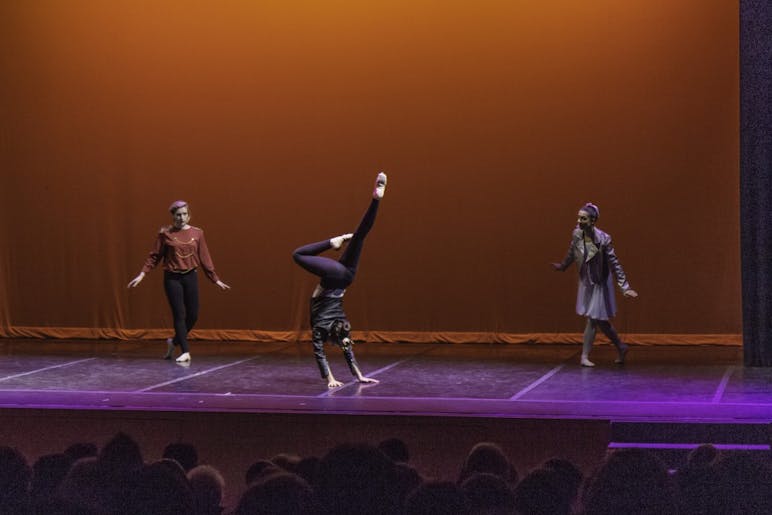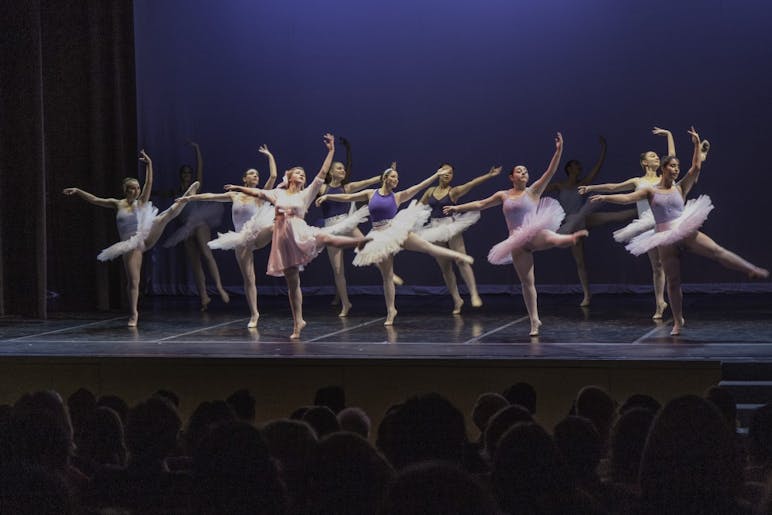‘Nutcracker’ dances toward inclusivity
The impression of ballet I had from years of dance classes was that of an exclusive, cold and uncaring environment. It was a culture that constantly told me, “You’re too fat to do real ballet,” “White girls are just naturally built better for ballet,” and “One bad injury and you might as well throw away your leotards.” Perfection was all that mattered. One noticeable mistake was as bad as not knowing the entire combination.
Brandeis Ballet Club clearly did not ascribe to any of these archaic ballet practices that exclude dancers based on weight, height, experience, race and ability. I was first struck by the racial diversity in Friday’s performance of “The Nutcracker.” In the many ballets I have seen, there usually isn’t a single non-white dancer, but this small 17-dancer ensemble featured performers from a variety of ethnic backgrounds. What is more, they found a way to include every dancer so that each got their opportunity to shine, even if they were brand-new to the group or to ballet in general. The Ballet Club found a way to feature new dancers without putting less-experienced dancers in a position in which they might embarrass themselves. That fine line is hard to balance, but they did an excellent job.
By having multiple dancers play the lead roles in different scenes, the directors ensured that many dancers would get featured appropriately. The costuming was so well-done, flattering to every dancer, and so clear that there was never a question of which character a dancer was portraying. The Snow Queen, Hannah Borgida ’21, wore a beautiful tutu and crown that looked amazing with her skilled choreography and the Rat Queen, Hannah DeRoche ’19, got an edgy look with a studded leather jacket.

The lead role, Clara, was played by Molly Cady ’21, Polina Potochevska ’20, Liza Korotkova ’19 and finally Emma Belkin ’21. Cady excelled in every piece of choreography, acting, and was the most perfect fit for the role. Potochevska was also featured in many other large roles and skillfully performed in all of them. Despite her seemingly flawless technique, Korotkova seemed incredibly nervous in her many featured roles. She had a slight hiccup during the Russian Dancers combination and finally cracked a smile which seemed to loosen her up for the rest of the piece. I enjoyed watching her dance the rest of the ballet. Belkin was probably the best actress among the Claras and was perfect for the ending. All four dancers did an amazing job and brought something unique to the role.

Brandeis Ballet Club has gone from seven to 17 dancers in the last three years of producing this full-length ballet, led by co-presidents DeRoche, Potochevska and Korotkova. While I enjoy the traditional ballet, they modernized the piece by using some of the original music and some dubstep remix covers of the traditional Tchaikovsky music. While I wasn’t a fan of the choice to include modernized music, the adjusted choreography worked really well with dubstep and the dancers in that number.
A huge step in the right direction for diversity and accessibility within ballet was the inclusion of other dance groups. In the Land of the Sweets, when our heroine, Clara, would usually run into groups of candy from China, Spain and Arabia, she ran into Platinum Step Team, Ballroom Formation Team, Toxic Majorette Dance Line and Hooked on Tap. It was a really cute idea that just lacked a bit of contextualization. Toxic’s routine was amazing, as it blended music from Dance of the Sugar Plum Fairy into their style of music, which brought us back to the ballet. Otherwise, it was a bit confusing and felt unnecessary if you didn’t know the original ballet. There were immense tech issues with the sound that became physically painful at one point. They had recorded a voice-over telling the story of the ballet that was so horribly recorded, the small child next to me kept saying he wanted to leave.
But the most inclusive aspect of the piece was Meredith Roberts ’21, who stepped on stage in the first scene as Drosselmeyer. She had suffered an injury that forced her to use a crutch and knee brace. She said that the presidents of the club had first asked her if she would still like to be involved in the show after her injury, and modified choreography to ensure she could still be featured. This really set the stage for what this group set out for: inclusivity. The group may have sacrificed tight, complex choreography, but they made sure to include everyone who wanted to be there and still put on an amazing piece, showcasing everyone in their own way. This felt like a small family of supportive dancers coming together to perform a beautiful piece instead of the cold, harsh, cattiness so often associated with ballet. Brandeis Ballet Club proved their commitment to diversity and inclusivity during their rendition of “The Nutcracker.”



Please note All comments are eligible for publication in The Justice.